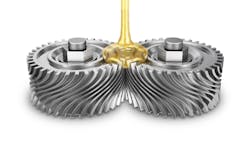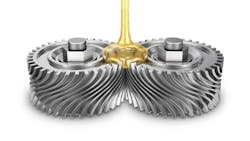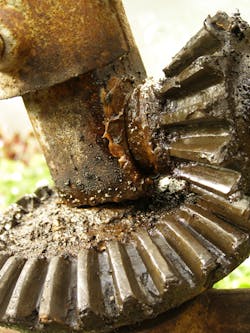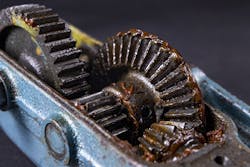This article was updated March 6, 2023. It was originally published Aug. 1, 2001.
Gears—even plastic ones—need to be lubricated if engineers are going to coax the best performance out of them. In the past there was little question as to what type of lubricants engineers and designers would recommend: petroleum-based oils. But synthetic oils have come to dominate high-end lubricants in terms of performance, while greases are now formulated to be suitable for gears and are the least expensive type of gear lubricant.
Here's a quick look at synthetic oils and greases suitable for gears (even those plastic ones).
Synthetics’ Advantages
As gears get smaller and spin faster, they generate more heat. Sometimes that heat proves too much for petroleum-based lubricants, which is why most OEMs use synthetic lubricants to handle the high temperatures. For comparison, petroleum starts breaking down around 212°F (100°C) and becomes unusable when it gets colder than 0°F (−18°C) while synthetic lubricants are still keeping gears spinning at temperatures from −130 to 500°F (−90 to 260°C).
Engineers and designers are also turning to synthetics for gears and other assemblies when temperatures are not an issue; they specify them for the improved performance and ability to fine-tune the lubricants at a molecular level so that their characteristics match the application’s needs.
Synthetics better resist oxidation at elevated temperatures—i.e., they have better thermooxidative stability. Oxidation degrades lubricants and lowers their performance. Worse yet, the resulting oxides are abrasive and prematurely wear out gears and other components. Synthetics are also not as volatile at elevated temperatures as petroleum-based lubricants.
Synthetics have more film strength than petroleum. Lubricants form a film over parts, lowering friction and wear. If the film breaks, that protection is reduced.
Synthetics also have higher viscosity indices than those of petroleum products. This means the viscosity of the base oil remains more constant as temperatures change.
Evaporation and fluid loss are less of a problem with synthetics; consequently, geared mechanisms use less synthetic lubricant per part.
With all these advantages, synthetic lubricants generally last three to five times as long as petroleum products of equal viscosity.
Synthetic lubricants make gears run smoother and last longer by forming a protective film between mating gear teeth. This widens the contact line between teeth and increases the area supporting the load. The end result is less pressure and wear on the gears.
There are six families of synthetic oils, each with its own skillset. Getting the right one, however, is key to ensuring smooth-running gears.
Synthetic hydrocarbons are the most popular synthetic lubricant for gears and gearboxes. They work at temperatures as low as −76°F (−60°C) and resist oxidation. They will work with a host of plastics and are relatively inexpensive compared to other synthetics.
Synthetic esters are compatible with many metals, including iron and steel. This makes them well suited for cut and powdered metal gears. They also withstand temperatures as high as 356°F (180°C). This makes them popular for gears in automotive superchargers and other severe-duty applications.
Polyglycols work well brass and phosphate bronze. This makes them common for worm gears.
Silicones and perfluoropolyethers (PFPEs) are compatible with nearly all plastic gears. Both withstand a broad range of temperatures and have good low-temperature torque characteristics. PFPEs resist harsh chemicals, such as sulfuric acid, hydrochloric acid, alkalis, halogens and petroleum solvents. And some PFPEs have low vapor pressure, an essential characteristic for vacuum chamber and aerospace applications where outgassing is a problem.
Polyphenylethers (PPEs) have found a few niche gear applications. For instance, PPEs resist radiation, making them well-suited for gears in medical and dental equipment.
Greases’ Advantages
Although oils have been the go-to lubricants for gears, they are more expensive and more likely to leak than synthetic greases. Going with grease also eliminates the cost and complexity of oil seals.
Synthetic greases can be light, tend to stay where they are put, and can handle low-torque applications. Many engineers mistakenly believe that only conventional gear oils will work on low-torque gears. Greases can be formulated light enough to work in small gear motors. In fact, gear greases can be made so soft they flow under shear stiffen into a gel when static.
Greases are a mix of powdered material, or thickener, and a base oil. Thickeners include sodiums, clays and soaps (such as lithium) and synthetic materials (such as PTFE). The right oil is crucial in greases for gears because it dictates the grease’s characteristics.
Although greases can be used in high- and low-speed gearboxes, the housings should have few if any open spaces which can trap grease away from the moving parts that need lubrication.
What About Plastic Gears?
Plastic gears are often designed to operate without lubrication; they have solid lubricants embedded in the plastic. But in the pursuit of the best performance and longest life, many engineers have discovered that traditional or external lubrication improves both. In fact, even lightly loaded, low-speed plastic gears last longer and run quieter with lubrication rather than without it.
A grease for plastic gears must have a base oil compatible with the plastic and its additives. Those additives, as well as material densities, affect that compatibility.
Although lubricants do not affect most thermoplastics, some base oils craze, crack or embrittle various plastics and elastomers. Esters, diesters and polyesters, for example, are well known as incompatible with polycarbonate, PVC, polystyrene and ABS resins. Fluoroethers, on the other hand, are the only lubricants inert enough to be safe with most components. Many manufacturers provide compatibility charts, but testing is the only way to guarantee the plastic material and lubricants are compatible.
How well lubricants stick to gears is another design consideration. If the lubricant doesn’t adhere well to the gear, it can be flung off when the gears spin. Tackifiers—additives that help grease stick to gear teeth—are usually recommended for plastic gears because they reduce or eliminate the lubricant being splattered around.
Embedded lubricants, such as PTFE and silicone, can limit oils from forming an adequate film between gear teeth. Design teams selecting an external lube for plastic gears in their applications should opt for gears without embedded lubricants or ensure the embedded lubricants will work with the base oil in the external lubricant. Oftentimes, however, the external lubrication eliminates the need for embedded lubricants in the plastic gears.
When a company got ready to introduce an N-class fractional hp gearmotor to the appliance marketplace, it used high-temperature, engineered plastic gearing. Class N motors lock oven doors during self-cleaning cycles when temperatures hit 450°F (232°C). The motors also unlock the doors during cool-down cycles. Unfortunately, the gears were failing before the required 6,000 cycles.
The problem was solved by installing external lubrication with a synthetic grease consisting of fluorinated oil (PFPE) and fluorinated thickener (PTFE). PFPEs handle temperatures up to 482°F (250°C) for extended periods and are compatible with plastics, elastomers, and metals.
After 6,000 cycles of testing, the motors showed minimal wear while surpassing UL requirements and a typical oven’s life.
The PFPE/PTFE greases are some of the most expensive ones around; it cost this company roughly $100/lb. Good thing a little goes a long way. Each gearmotor only needed about four cents worth of grease.
Jeffrey Lay, was gear industry director at Nye Lubricants Inc. when this article first appeared.




